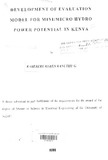| dc.contributor.author | Kaberere, Keren Kanuthu G. | |
| dc.date.accessioned | 2013-05-04T12:32:58Z | |
| dc.date.available | 2013-05-04T12:32:58Z | |
| dc.date.issued | 1999 | |
| dc.identifier.citation | A thesis submitted in part fulfillment of the requirements for the award of the degree of Master of Science in Electrical Engineering of the University of Nairobi. | en |
| dc.identifier.uri | http://erepository.uonbi.ac.ke:8080/xmlui/handle/123456789/19061 | |
| dc.description.abstract | As witnessed by the developed countries, rural electrification (RE) is of paramount importance for the development of a nation. It serves many social and economic purposes. Since the majority of the people in developing countries live in the rural areas, there is a need for these nations to address themselves to the real problems of rural electrification. The dominant method used for lighting up these areas is national grid extension which quite often proves to be very expensive due to the dispersed nature of rural population distribution and very low power consumption. Diesel generators have also been used to serve remote areas but these are not very appropriate because they require skilled maintenance and their running costs are very high especially where fuel is imported. Even the oil producing countries do seek alternatives due to the realization that oil is a depletable resource. Cheaper and more appropriate technologies for lighting up the rural areas must therefore be sought and most countries are turning to renewable resources. Of all the renewable sources, mini/micro hydroelectric power (MHP) has been found to be the cheapest and moreover, it raises very little environmental concern.
In this study an evaluation model for MHP has been developed for applications in Kenya. This model performs the technical design of plants of capacity up to 500kW. It is based on relevant mathematical formulae and engineering considerations applicable to hydro power plants of this range. The power demand of the potential consumers should be estimated as a pre-condition for the use of the model. The model matches the discharge rate corresponding to the potential power demand and the river discharge rate to determine the design discharge rate. Where the demand surpasses the supply, a 70 percent exceedance design discharge rate is recommended. Storage reservoirs have been found to increase the project cost drastically due to the fact that a darn would have to be constructed and the excavation work involved. They should therefore be avoided.
The study concentrates -eftoo-A. C. generation. single phase for plants upto 10kW and three phase above this rating. The choice of an induction generator can be made whenever it
costs less than the equivalent synchronous generator which has been found to be upto
25kW. For plants of capacity up to 200kW, Electronic Load Controllers (ELC) may be used with synchronous generators and beyond 200kW a speed governor is recommended. The use of a step-up transformer is only considered when the power to be transmitted exceeds 40kW.
The effect of interest rate charged on capital and discount rate have also been investigated and it has been found that the higher these rates are, the lower the Net Present Worth (NPW) of a project becomes. The unit cost of generation of power decreases as the annual capacity factor improves and as the useful life of a project increases. Unit cost of diesel generation was found to be higher than MHP for values of capacity factor above 17.5% for the plant studied. Although the unit cost of generation for both MHP and diesel decreases individually as the annual capacity factor improves, the difference in cost between the two sources widens as the annual capacity factor Improves. | en |
| dc.language.iso | en | en |
| dc.title | Development of evaluation model for mini/micro hydro power potential in kenya | en |
| dc.type | Thesis | en |
| local.publisher | Department of Electrical Engineering | en |

